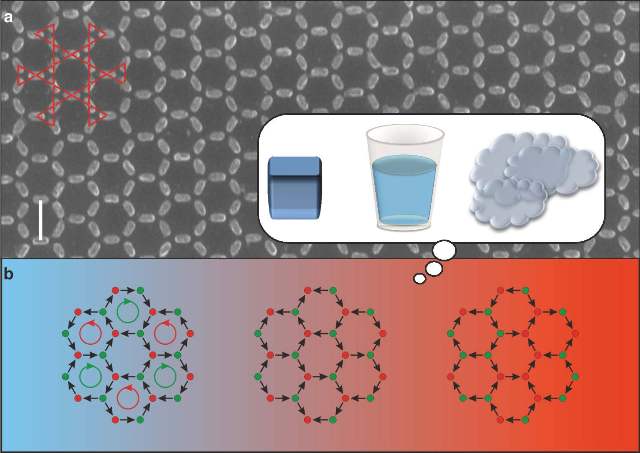Researchers at the Paul Scherrer Institute (PSI) created a synthetic material out of 1 billion tiny magnets.
 PSI researchers have created a magnetic metamaterial made of long nanomagnets, arranged in a flat, honeycomb pattern. The arrangement of magnetisation in the synthetic material assumed very different states at different temperatures – just like molecules in ice are more ordered than in water, and are in turn more ordered in water than in steam. (Image: PSI/Luca Anghinolfi)
PSI researchers have created a magnetic metamaterial made of long nanomagnets, arranged in a flat, honeycomb pattern. The arrangement of magnetisation in the synthetic material assumed very different states at different temperatures – just like molecules in ice are more ordered than in water, and are in turn more ordered in water than in steam. (Image: PSI/Luca Anghinolfi)
A remarkable discovery about the new metamaterial is that its magnetic properties vary with the temperature, enabling phase transition between different states. The transition of this material happens in the same way as water changes to the solid, gaseous and liquid states. This nanomagnetic material can be refined further for future use in electronics applications, such as enabling more efficient information transfer.
The metamaterial transforms into different aggregate states based on the temperature changes. This phase transition was observed by the research team led by Laura Heyderman from PSI.
We were surprised and excited. Only complex systems are able to display phase transitions. Since complex systems enable new types of information transfer, the results of the study suggest that the metamaterial developed by the PSI research team would find potential applications in information transfer.
Heyderman
The main advantage of the metamaterial is that it can be customized easily. According to the researchers, it is not possible to rearrange the individual atoms in a natural material precisely on a large scale. However, they say that such precise rearrangements can be made in case of nanomagnets.
Honeycomb of Nanomagnets
The nanomagnets are shaped like rice grains, with a length of 63nm. As many as 1 billion tiny grain-like nanomagnets are arranged on a flat substrate in the form of a large-scale honeycomb pattern using a highly advanced method. The honeycomb of nanomagnets covers a total area of five by five millimetres.
Initially the collective magnetic behaviour of the metamaterial at room temperature was studied using a special measuring technique. The initial studies revealed that there was no order in the magnetic orientation of the material: the magnetic south and north poles were pointing in random directions.
When the material was cooled in a continuous and gradual manner, a higher order was observed at a point; the magnets took notice of neighbouring magnets more than before. On further reduction in temperature, another change occurred tending towards an even higher order. The magnetic arrangement at this higher order state appeared frozen. Water also exhibited similar behaviour by increasing the long-range order of its molecules when it freezes into ice. “We were fascinated by the fact that our synthetic material displayed this everyday phenomenon of a phase transition,” says Heyderman.
Customizable Metamaterial
The researchers plan to investigate further by influencing magnetic phase transitions through changes in the size, arrangement and shape of these nanomagnets. Such phase transitions enable the creation of new states, which could be used in potential applications.
The beauty of it all: tailored phase transitions could enable metamaterials to be adapted specifically for different needs in future.
Heyderman
Apart from its potential application in information transfer, the new material may also be used in data storage or in sensors that measure magnetic fields. It could also find generic applications in spintronics, contributing towards the developments in electronics in creating new computer technology.
The measurements associated with the magnetic orientation of the nanomagnets, and research into the properties of the material can be conducted only at the PSI. A unique instrument at the SµS projects the beams from muons, an exotic elementary particle, for studying the nanomagnetic properties of materials. A research team led by Stephen Lee from the University of St Andrews, Scotland, also contributed to the study.
References